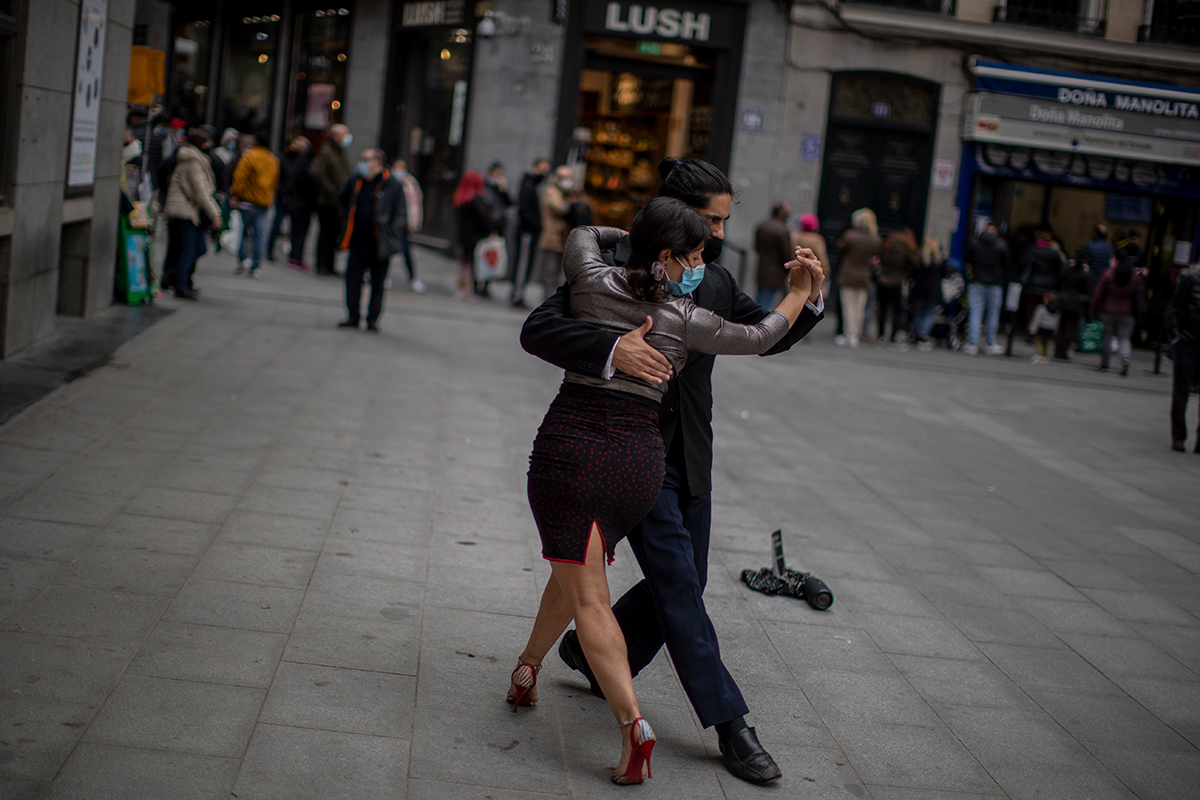Written by , Ryerson University; , Ryerson University; , Ryerson University. Photo credit: AP Photo/Manu Fernandez. Originally published in The Conversation.![]()
Street dancers wearing face masks dance the tango in Madrid, Spain, Dec. 16, 2020.
To say that 2020 has been rough for the cultural and creative industries is an understatement. More specifically, COVID-19 has been nothing short of a perfect storm for workers in those industries, who already experienced precarious conditions. Venue closures and travel restrictions have affected other economic sectors, such as hospitality, on which many workers depend to make ends meet.
If this pandemic were a natural disaster, it would be as if the tides kept on bringing oil to already devastated shores, day after day after day. In the end, who can we count on to provide some of the much needed “post-disaster” assistance, and when?
Research on disaster management offers insights into these questions. Interestingly, it suggests that future assistance will need to look a lot different than the responses seen to date.
Adverse impacts
Almost a year into this pandemic, it feels as if everything has been said. We know all too well about the struggle, the layoffs and the dire financial situation many artists now find themselves in. We know about artists and other creative professionals moving on to more stable, greener professional pastures — at times in a literal sense as they leave cities that they were increasingly priced out of pre-pandemic. Perhaps more worrisome, we also know about the mental toll of prolonged inactivity and isolation.
Yet, we have also regularly been privy to glimpses of hope, promising innovations and we’ve marvelled at the adaptations of a generally resilient arts sector.
Think back to when news media extensively covered the the phenomenon of people singing or playing instruments from their balconies. Despite the crisis, many established artists found ways to engage the public and some people in quarantine filled time with crafts or their windows with paintings.
Such positive moments remind us of the value and power of creativity, but they sit, of course, in the context of grief, anxiety and exhaustion.

Beyond immediate relief
There is now a need to look also beyond immediate relief to deal with artists’ short-term needs met through things like emergency benefit schemes, wage-subsidy programs and other forms of cash injections. The subsequent “chronic” stage efforts will need to focus on cleaning up, conducting post-mortems or self-analysis and perhaps more importantly, on healing.
Applied to the cultural and creative industries, this involves asking tough questions on the current working conditions, financial stability and social recognition of artists, as well as extending sustained non-monetary support such as counselling for those who have had to weather a seemingly perpetual storm.
Only then can the sector turn to long-term rebuilding strategies, which must include reinvestment strategies.
Role of growing creative sectors
Recent disasters, natural or man-made, show that help for devastated communities tends to come from those who have been for the most part unaffected by the situation. For example, over 90 countries provided logistical and financial assistance to New Orleans following Hurricane Katrina in 2005, much like many nations across the word were quick to come to Beirut’s rescue after last summer’s horrific explosions. On the surface, this may seem hardly applicable in a context of a global pandemic that has impacted most people in some shape or form.
However, when it comes to the cultural and creative industries, a handful of sectors such as the video game industry and streaming platforms such as Netflix have actually experienced record growth over the past months.
We suggest that those companies that have weathered the storm, if not flourished during the pandemic, should launch joint initiatives, production support, sponsorships and dedicated programs for individual artists or small organizations.
Furthermore, the collective expertise among these sectors could support digital transformation initiatives for those that did not previously rely on online outreach. This includes the development of tailor-made, but scalable immersive experiences that allow audiences to engage with creatives in a digital first, or hybrid digital-offline context.

Safer, more accessible venues
In addition to reinvestment, infrastructure considerations and dedicated communications efforts have an important role building up sustainable arts communities and enterprises. Redesigning venues to make them more accessible, but also much safer for both patrons and artists is significant. In addition, what’s needed are government programs to support not just artists’ productions, but also cost of living and rent stabilization subsidies.
Beyond this, government investment to promote audiences’ consumption of artistic goods and services also matters. Once the pandemic is over, overcoming the stigma of mass gatherings and the public’s residual fears is also likely to be an everyday communication battle, one in which the entire cultural sector will need to come together in a concerted effort to encourage people to go out.
University space for incubation
Likewise, while the rest of the economy was taking a battering, universities remained reasonably safe and privileged despite the collapse of the international student market. It is also the responsibility of universities to help by offering spaces and programmatic support for experimentation and incubation of creative projects, as well as reskilling programs and research initiatives into the future of these sectors.
The current pandemic has shocked many of us into an awareness of the threat posed by disasters particularly given the world’s interdependence and complexity. This is why we need to develop much more sophisticated contingency, rescue and recovery strategies, in which stakeholders other than just governments are compelled to come together and support each other in times of crisis.

